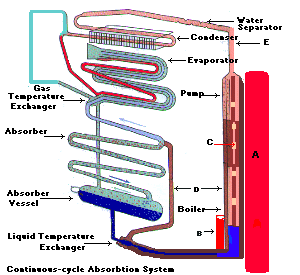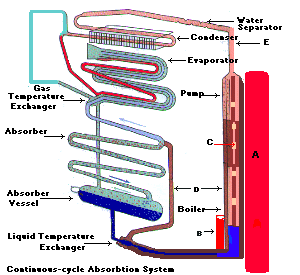SMALL AMMONIA REFRIGERATOR
Anhydrous Ammonia (Nh3) has been used for many years to perform all types of
refrigeration and air conditioning chores. Anhydrous Ammonia means ammonia
without water, Aqua Ammonia is a solution of ammonia and water which is used in
refrigeration and air conditioners that are not a vapor compression type. Vapor
compression systems use compressors to compress the ammonia vapor. Absorption
type systems do not use a compressor but instead use a generator. These systems
shall be the main topic of the following chapters. It is assumed by the Author
that you have some knowledge of refrigeration and are aware of the cycles and
pressures of refrigeration in general. Please refer to our available Browser
Books on the subject if you are not. Ammonia Refrigeration Basics is a
good source of basic information should you require a better understanding on
the subject.

Example:# 101A
THE GENERATING CYCLE
The Intermittent absorption system uses a generator charged with water and
ammonia. A heat source, usually a kerosene flame, heats this solution in the
generator. The ammonia is vaporized and driven off.
A condenser, at the top of the system, condenses the ammonia vapor into a
liquid. The liquid flows by gravity into the liquid receiver shown above and
then into the evaporator. During the generating cycle, little or no
refrigerating effect is taking place. As the system cools, the pressure drops,
causing the liquid ammonia in the evaporator to boil (flash off) and absorb
heat. The cycle is completed when vaporized ammonia is re-absorbed in the Aqua
ammonia solution in the generator.
Example: 101A illustrates the generating cycle, in operation, the
kerosene burner tank is filled with just enough kerosene for one cycle. This
cycle is usually once a day. The burner is filled and lighted. It heats the
water and ammonia mixture (Aqua Ammonia) (Brown Mixture) in the generator. The
ammonia vapor (Tan Color) is driven off through the tube, (A) up to the air
cooled condenser. There the ammonia gas is cooled and condensed to liquid
ammonia (Red Color). The liquid flows into the receiver. Note the one way check
valve between the condenser and the liquid receiver, it serves to restrict any
back flow of liquid into the condenser. Also notice the small restrictor port
which will be covered below during the refrigeration cycle of the system.
When the kerosene has all been burned (usually from 20 to 40 minutes), the
generating cycle ends.
THE REFRIGERATION CYCLE

Example:#101B
The pressure in the system drops as the water cools and absorbs ammonia vapor.
Liquid ammonia (Light Blue) flows into the evaporator, begins to evaporate, and
cools it. Evaporated ammonia (Aqua Blue) flows back through the tube (B). It is
again absorbed by the water in the generator. Refrigeration continues, usually
until the next firing of the kerosene burner. The small restrictor perform two
functions, it allows the liquid to enter the evaporator at a controlled level.
This protects the evaporator from getting flooded. The restrictor also acts as a
expansion valve which greats a pressure differential. A pressure differential is
essential to the refrigeration cycle as it causes the liquid ammonia to change
it's boiling point from a high pressure flash of temperature to a lower pressure
flash off temperature. Without this change in pressures the refrigeration would
not be performed and the system would simply act as an ammonia container.
This type of refrigerating system is quite simple. The piping is welded steel
because the pressures on the generating cycle are quite high. The refrigerating
ability is quite good. Kerosene flame heated absorption refrigerators are
popular in areas where electric power is not available.
Other means of firing the burner can be propane or natural gas. Many RV unit
refrigerators use a combination of propane fired burners and add a small 12 volt
fan assembly to improve cooling within the evaporator section of the
refrigerator (Ice Box).. Many types of absorption systems are on the market
these days and are not limited to small appliances. The theory can and has been
applied to very large commercial systems and perform in much the same manner.
Most small RV type refrigerators are not field repairable due to the critical
charge ( The right amount of Aqua Ammonia ) and the nature of the system
construction. If a small unit develops a leak, the best thing to do is replace
it with a new one. Most manufacturers design the units to last for a very long
time, but a damaged unit should be replaced (Leaking). Maintenance can and
should be performed on the burner assembly and the piping that feed the propane
or kerosene. Most Aqua Ammonia leaks are easy to find as are Anhydrous Ammonia
leaks the smell is very strong and aids in detecting even the smallest of leaks.
CONTINUOUS-CYCLE ABSORPTION SYSTEM

Example:# 101C
There are other types of absorption systems available, the continuous-cycle
absorption cooling unit is operated by the application of a limited amount of
heat. This heat is furnished by gas, electricity, or kerosene. No moving parts
are employed. The operation of the refrigerating mechanism is based on Dalton's
Law.
DALTON'S LAW
Dalton's Law of partial pressures is the foundation of the principle of
operation of one of the absorption type refrigerating systems. The Law States:
The total pressure of a confined mixture of gases is the sum of the pressures of
each of the gases in the mixture.
The total pressure of the air in a compressed air cylinder is the sum of the
oxygen, nitrogen, and the carbon dioxide gases, and the water vapor pressure.
The law further explains that each gas behaves as if it occupies the space
alone. To illustrate, the absorption refrigerator uses two gases, ammonia and
hydrogen. The ammonia, at room temperature, is absorbed by the water in the
closed sustem.
Heating this solution drives out the ammonia. (The hydrogen is not absorbed by
the water and remains as a gas.) Due to the pressure it is under, the ammonia
condenses into a liquid in the condenser. The pressure is uniform throughout the
system. Total pressure in the system is the sum of the vapor pressure of the
ammonia plus the hydrogen pressure. When the pressure of the ammonia vapor is
below the pressure corresponding to the vapor pressure for ammonia alone, the
ammonia continues to evaporate. It tries to reach a vapor pressure corresponding
to the temperature in the absorber.
This refrigeration device is widely used in domestic refrigerators, and
recreational vehicles. It is also used in year-around air conditioning of both
homes and larger buildings. The unit consists of four main parts the boiler,
condenser, evaporator and the absorber. When the unit operates on kerosene or
gas, the heat is supplied by a burner. This element is fitted underneath the
central tube (A). When operating on electricity, the heat is supplied by an
element inserted in the pocket (B).
The unit charge consists of a quantity of ammonia, water, and hydrogen. These
are at a sufficient pressure to condense ammonia at room temperature. When heat
is supplied to the boiler system, bubbles of ammonia gas are produced. They rise
and carry with them quantities of weak ammonia solution through the siphon pump
(C). This weak solution passes into tube (D), while the ammonia vapor passes
into the vapor pipe (E) and on to the water separator. Here any water vapor is
condensed and runs back into the boiler system, leaving the dry ammonia vapor to
pass to the condenser. Air circulating over the fins of the condenser removes
heat from the ammonia vapor. It condenses into liquid ammonia and then flows
into the evaporator.
The evaporator is supplied with hydrogen. The hydrogen passes across the surface
of the ammonia. It lowers the ammonia vapor pressure enough to allow the liquid
ammonia to evaporate. The evaporation of the ammonia extracts heat from the
evaporator. This, in turn, extracts heat from the food storage space, lowering
the temperature inside the refrigerator.
The mixture of ammonia and hydrogen vapor passes from the evaporator to the
absorber. A continuous trickle of weak ammonia solution enters the upper portion
of the absorber. It is fed by gravity from the tube (D). This weak solution
flows down through the absorber. It comes into contact with the mixed ammonia
and hydrogen gases. This readily absorbs the ammonia from the mixture. The
hydrogen is free to rise through the absorber coil and to return to the
evaporator. The hydrogen circulates continuously between the absorber and the
evaporator.
The strong ammonia solution produced in the absorber flows down to the absorber
vessel. It passes on to the boiler system, thus completing the full cycle of
operation.
This cycle operates continuously as long as the boiler is heated. A thermostat
which controls the heat source regulates the temperature of the refrigerated
space.
Since the refrigerant is ammonia, it can produce quite low temperatures. Most
systems require electrical devices, so both gas and electricity must be
supplied. Except for the thermostatic controls and (in some cases) fans, there
are no moving parts.
Service is usually quite simple. The burner and stack must be kept clean. The
refrigerator should be carefully leveled before being placed in operation.
The pressure differential in the type of system is created by the hydrogen gas,
it causes the ammonia to change pressure and allows it to boil off in the
evaporator (flash off).



